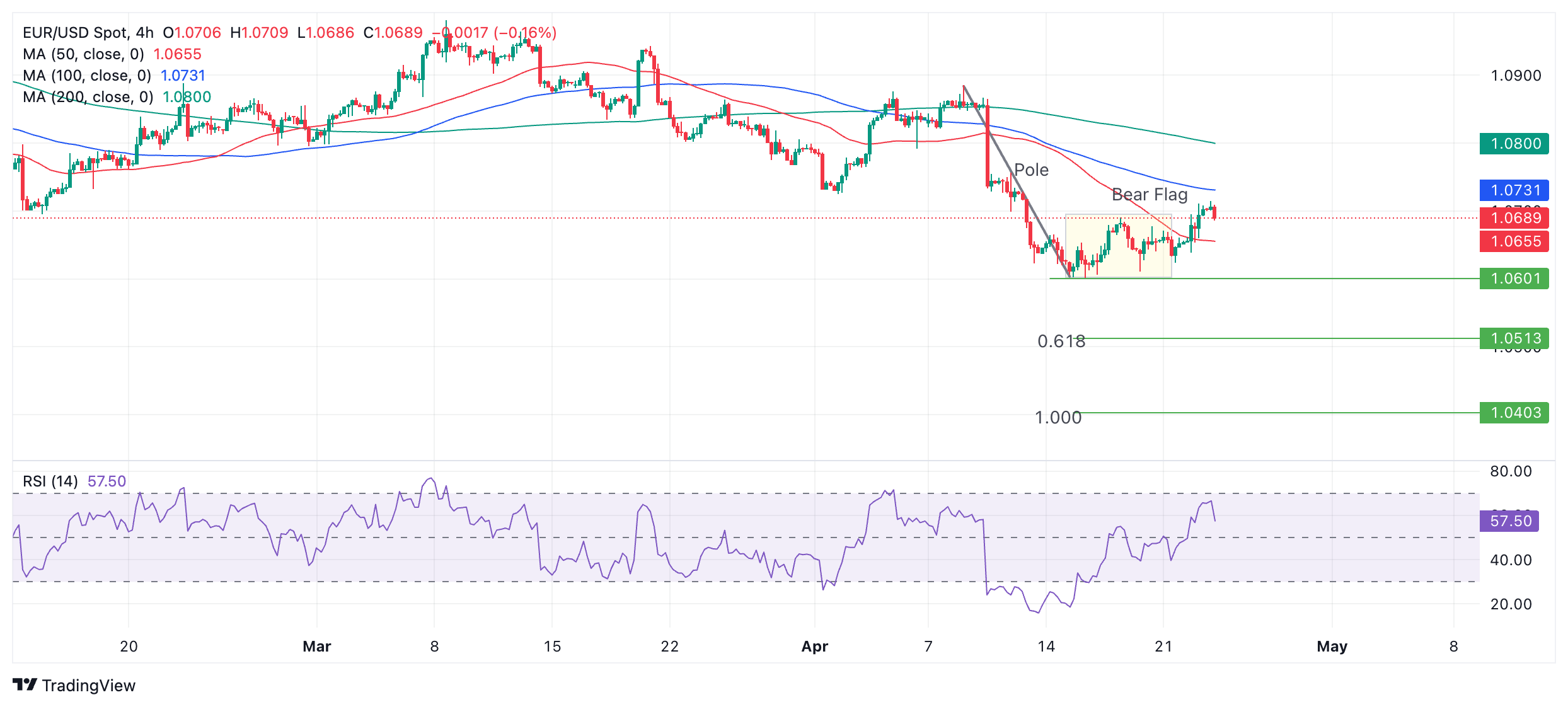- The EUR/USD pair breaks the key psychological level of 1.0700 early on Wednesday, but then trimmed gains.
- Tuesday's weaker-than-expected US PMI data weakened the US dollar and boosted the recovery.
- EUR/USD trims gains despite good IFO economic sentiment data from Germany.
The EUR/USD pair is trading just below 1.0700 on Wednesday, after weaker-than-expected US private sector growth and business activity put a dent in the myth of US economic exceptionalism. US, weighing on the US Dollar (USD) and lifting the pair over the last 24 hours.
However, the EUR/USD pair later pared its gains, despite the release of encouraging IFO survey data on German economic sentiment for the month of April. Data from the IFO Institute showed a larger-than-expected increase in the business climate (89.4) and current assessment (88.9) components, while expectations rose to 89.9 in line with estimates.
During the US session, EUR/USD shrugged off US Durable Goods Orders data, which rose 2.6%, or $7.3 billion, to $283.4 billion in March, according to the Bureau from the United States Census. This reading follows the 0.7% increase (revised from 1.4%) recorded in February.
EUR/USD recovers after weaker-than-expected US data
The EUR/USD pair broke above its seven-day range early on Wednesday after the dollar fell out of favor with investors. The Euro (EUR), for its part, performed better thanks to the growth of the services sector revealed by the Eurozone HCOB services PMI data for April, better than expected.
By comparison, US PMIs fell in both the manufacturing and services sectors in April, catching investors by surprise and suggesting that the economy is not performing as well as previously thought under the yoke of lower interest rates. relatively high interest.
Strong price momentum in the services sector, both in the US and Europe, has delayed the time when both the Federal Reserve (Fed) and the European Central Bank (ECB) are expected to lower interest rates . While ECB officials seem fairly unanimous in their desire to cut the ECB's base lending rate in June, Fed officials have become increasingly vague about when they might consider cutting interest rates.
As the expectation of lower interest rates depreciates a currency, the lack of commitment from Fed officials compared to their ECB colleagues has been the main catalyst for the US dollar's outperformance in recent weeks, and the EUR/USD bearish momentum.
However, preliminary Eurozone services PMI data, released on Tuesday and higher than expected, casts some doubt on confidence that the ECB will go ahead with rate cuts in June.
On Wednesday, ECB Governing Council member and Bundesbank President Joachim Nagel reflected this doubt by stating that “services inflation remains high, driven by continued strong wage growth” and, therefore, , was not convinced that inflation was falling sustainably and therefore could not “commit in advance to a particular rate path.”
This means that more weight will be given to the defining data for the decision, which is – according to the president of the ECB, Christine Lagarde – the Eurozone wage growth data for the first quarter.
Technical Analysis: EUR/USD Pierces Short-Term Range Part
The EUR/USD pair breaks out of the short-term range it has been trading in for the past seven days and breaks above the key 1.0700 level, calling into question the durability of the short-term downtrend.
It is now less certain that EUR/USD is forming a bearish flag price pattern as previously assumed. The pattern has quite bearish connotations with a potential bearish target at 1.0400, so if it does not activate the pair could revert into disappointment, with some short covering adding fuel to the recovery.
EUR/USD 4-hour chart

With the short-term downtrend in doubt, further upside is possible, with the next target at the resistance of the previous lower high, which provides an initial target at 1.0758. Next, the 50-day and 200-day SMA offer resistance at 1.0807 on the daily chart (not shown).
However, a break below the April 16 low of 1.0601 would prove that the bear flag hypothesis is valid and signal the start of a decline.
According to technical tradition, the expected exit move of a bearish flag is usually equal to the length of the “pole” or steep decline that precedes the formation of the flag square, or a Fibonacci ratio of the pole.
The 0.618 Fibonacci ratio of the extrapolated bearish pole provides the most reliable conservative target. This gives a price target at 1.0503. After that, the next concrete target is at 1.0446 – the October 2023 low. A drop of the same length as the pole would take EUR/USD to 1.0403.
economic indicator
Durable Goods Orders
Durable Goods Orders, published by the US Census Bureau, measure the cost of orders received by manufacturers of durable goods, that is, goods expected to last three years or more, such as motor vehicles and appliances. As these durable products usually involve large investments, they are sensitive to the economic situation in the US. The last figure shows the state of US productive activity. Generally speaking, a high reading is bullish for the USD.
Source: Fx Street
I am Joshua Winder, a senior-level journalist and editor at World Stock Market. I specialize in covering news related to the stock market and economic trends. With more than 8 years of experience in this field, I have become an expert in financial reporting.







